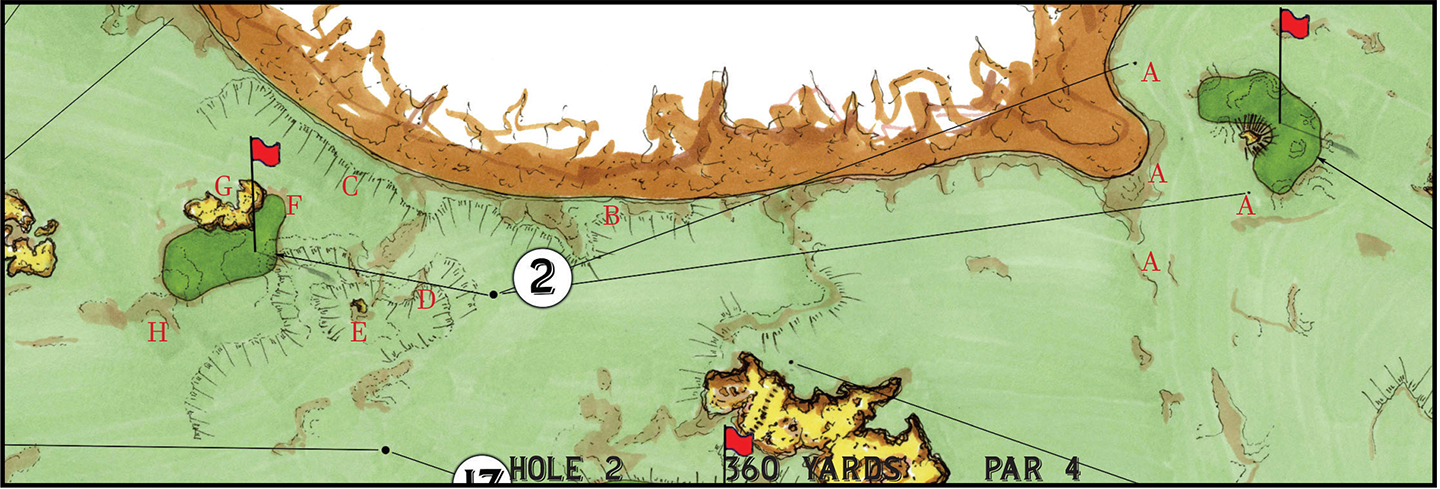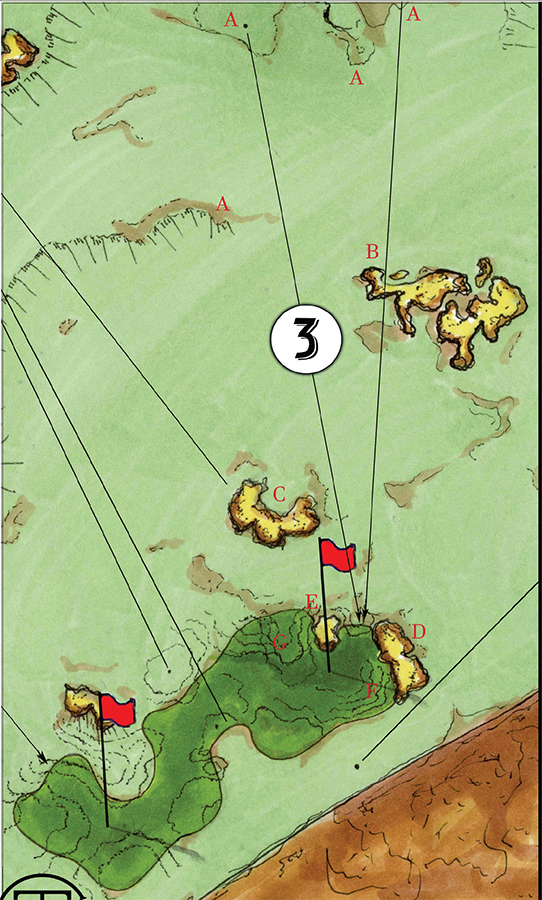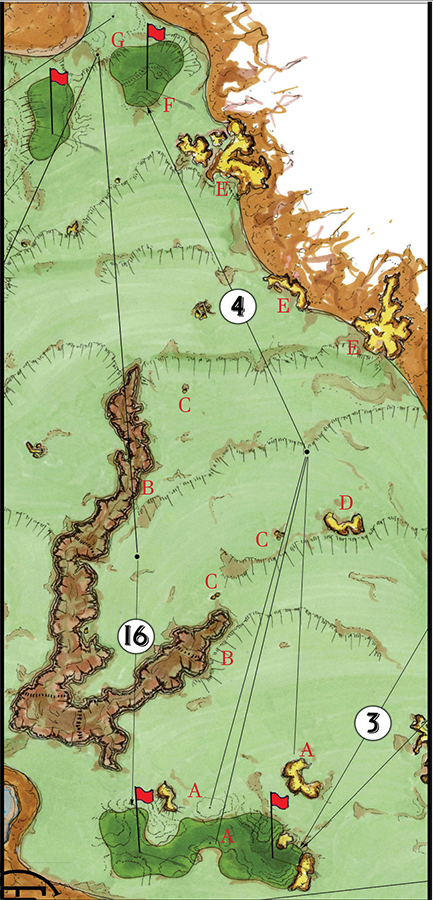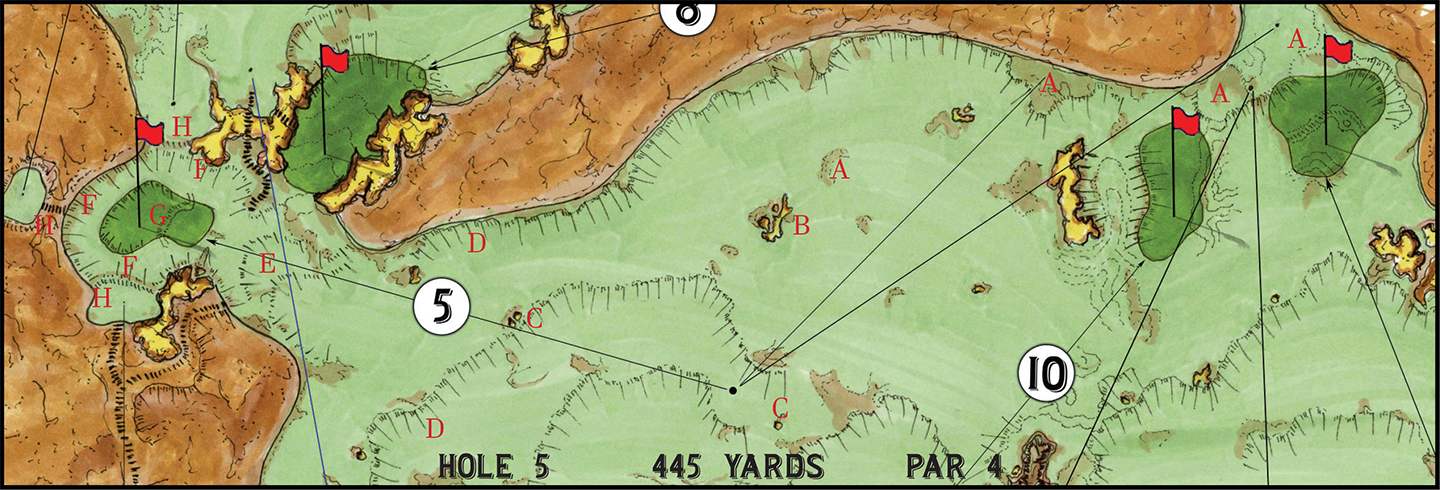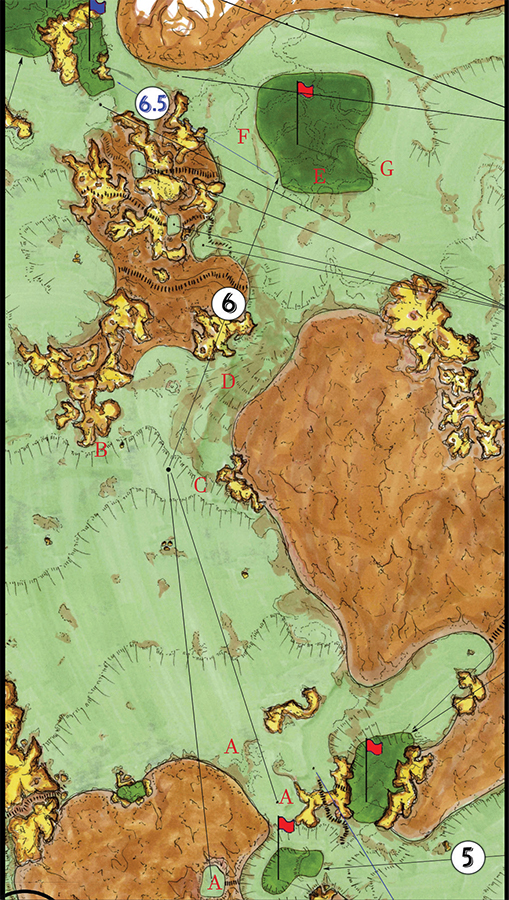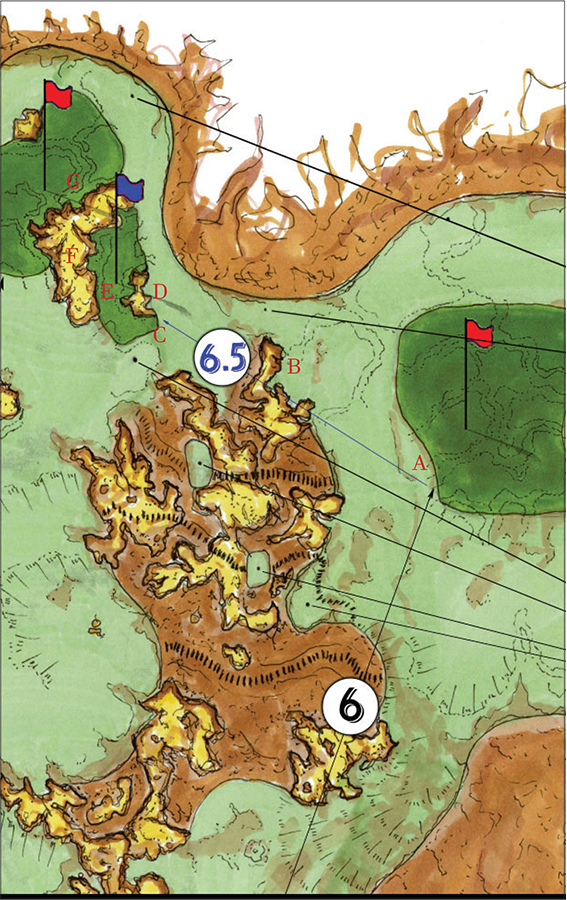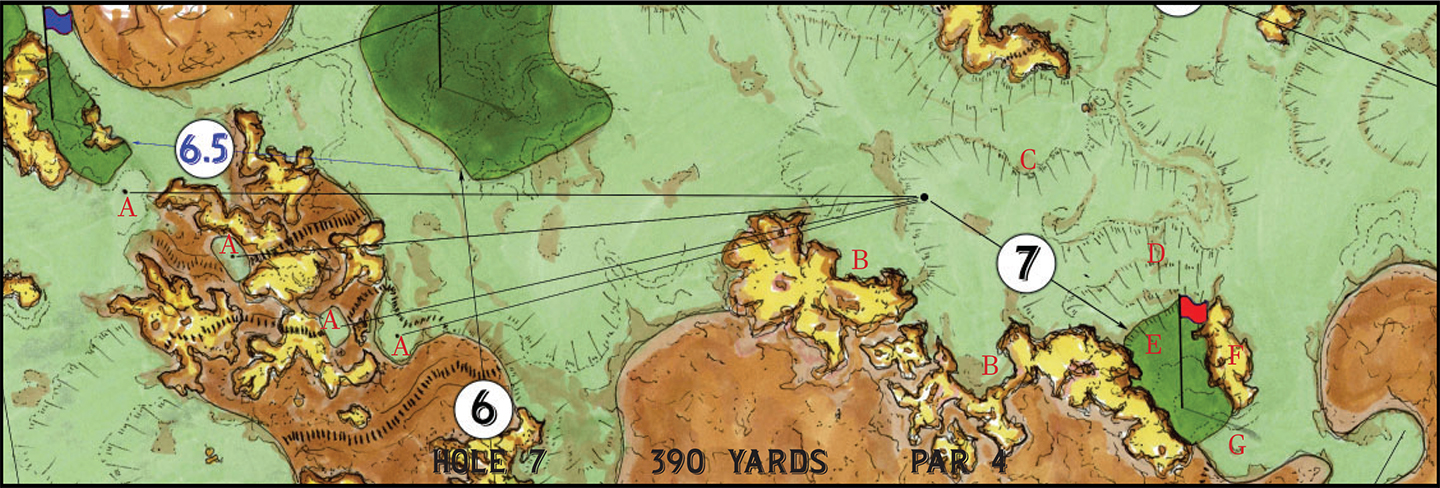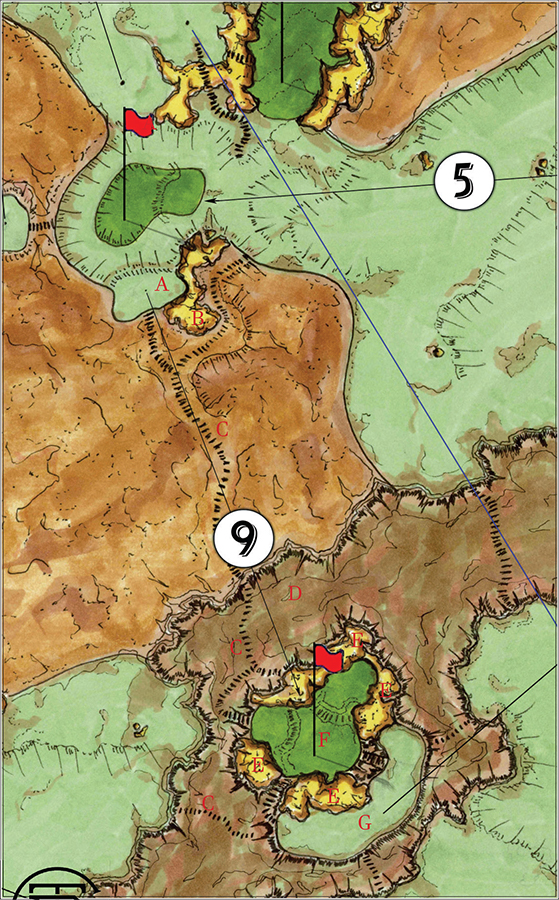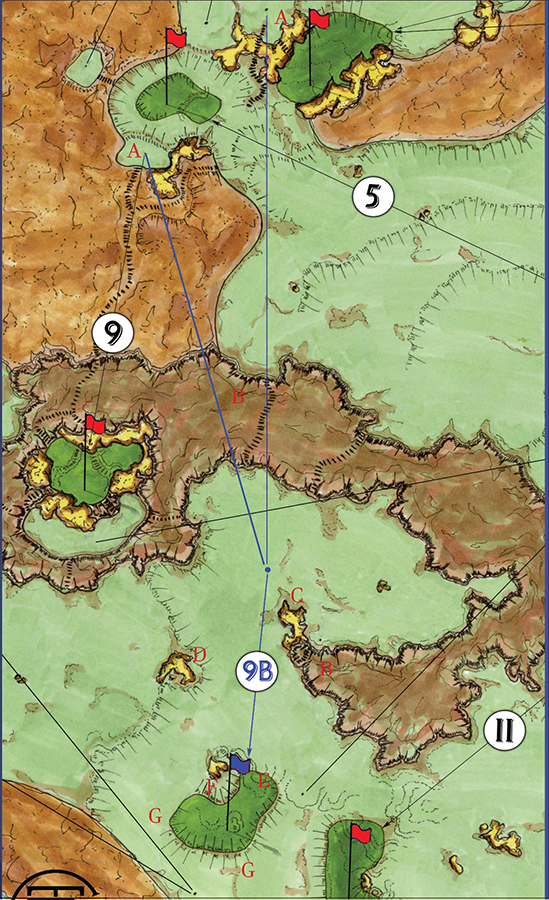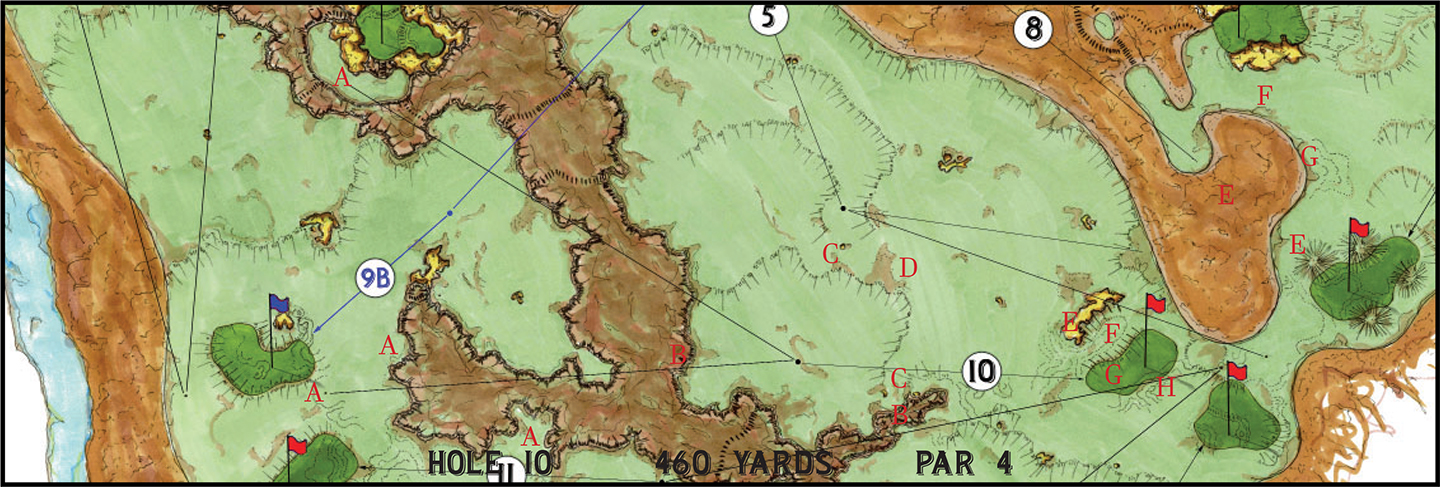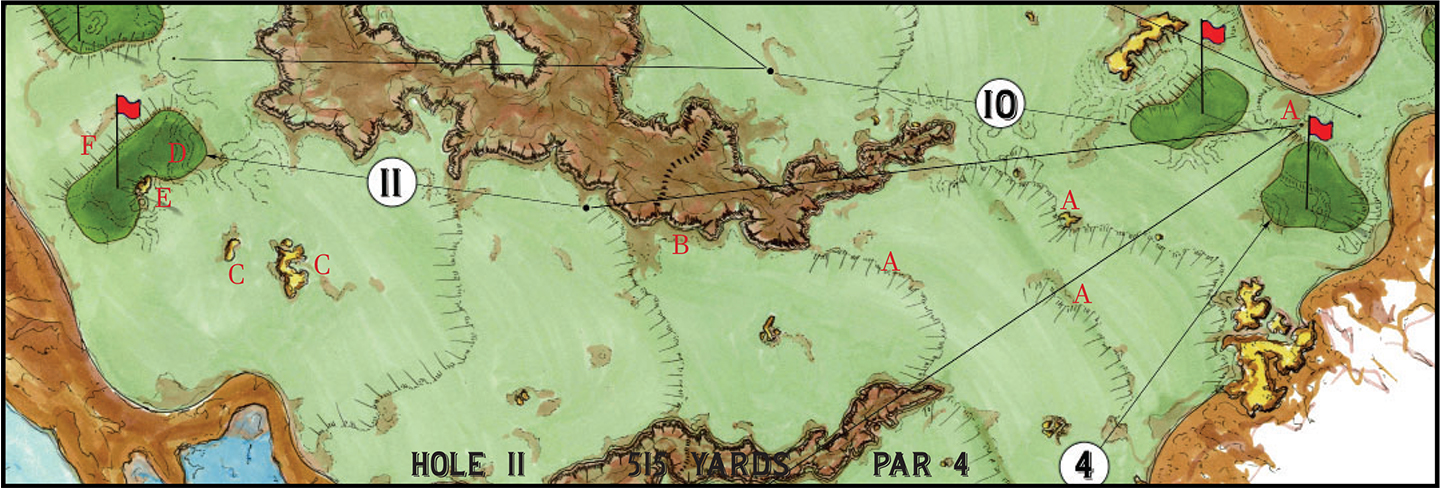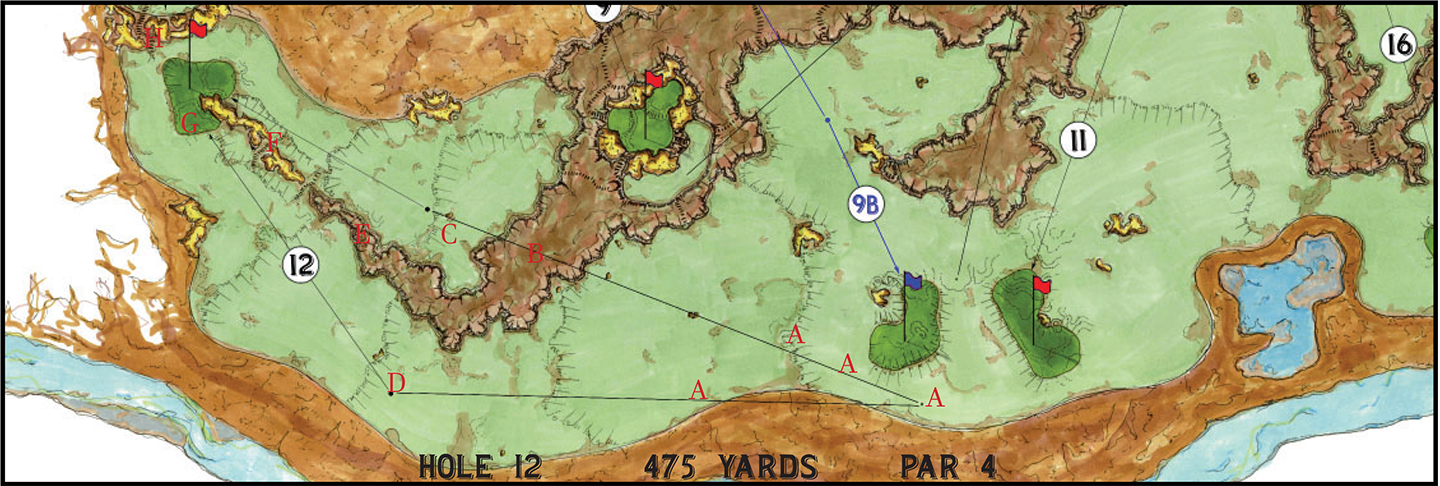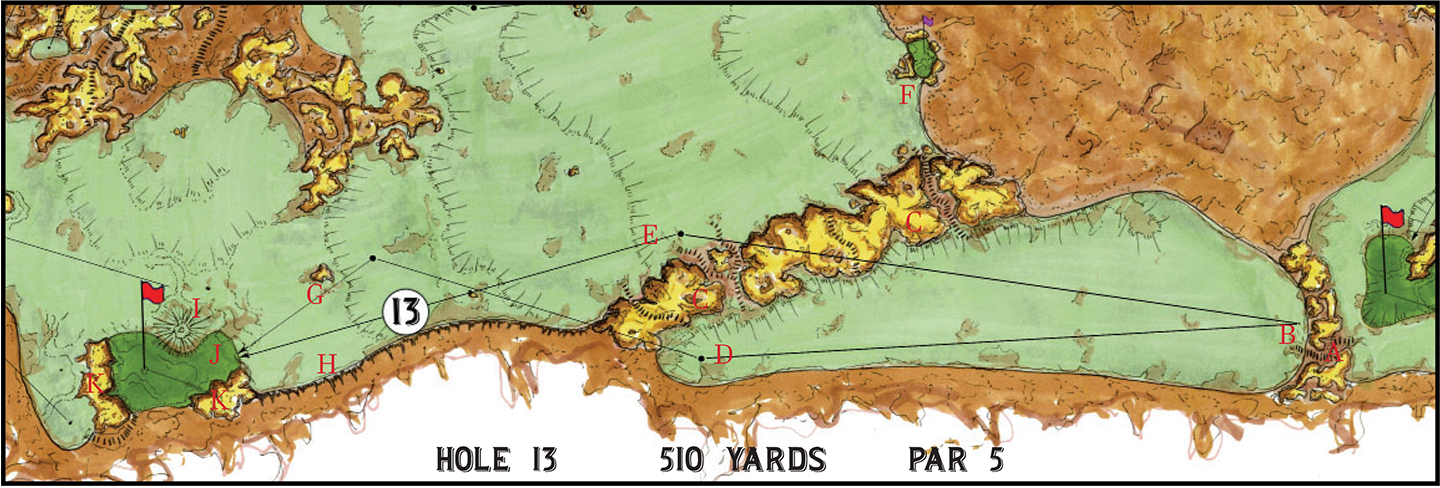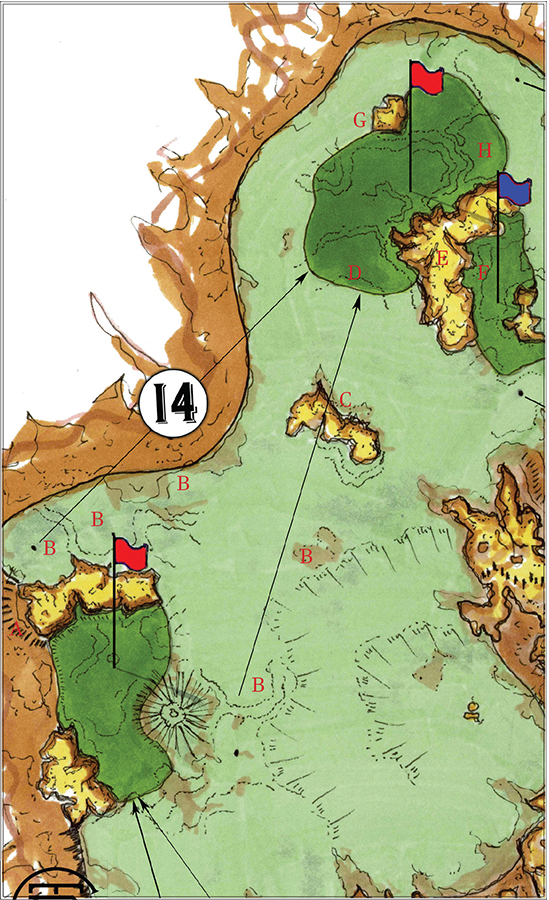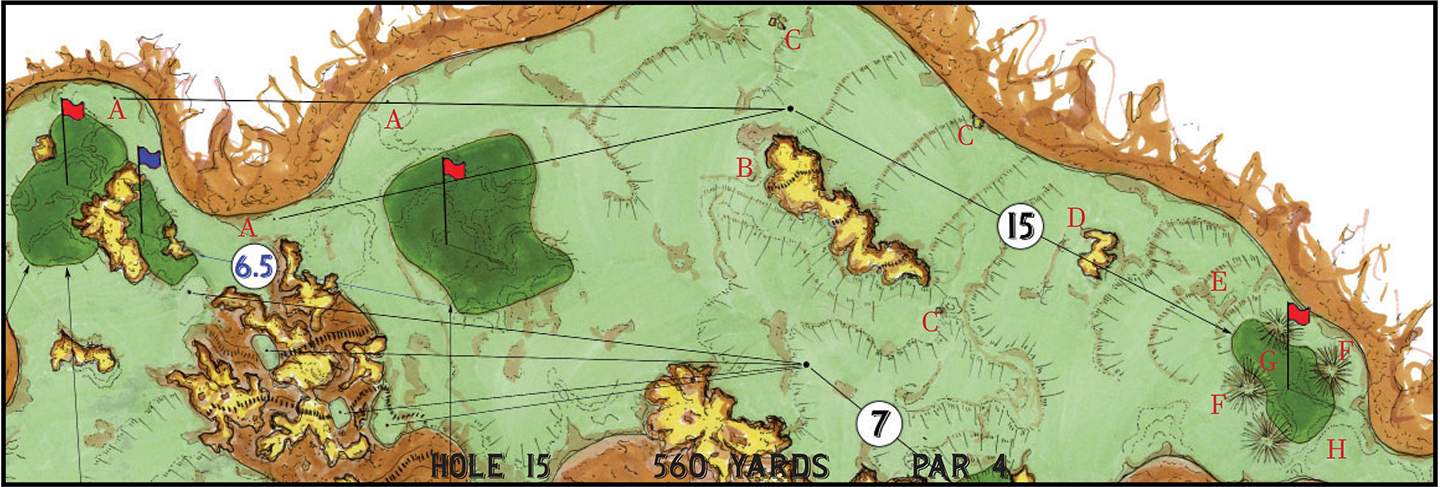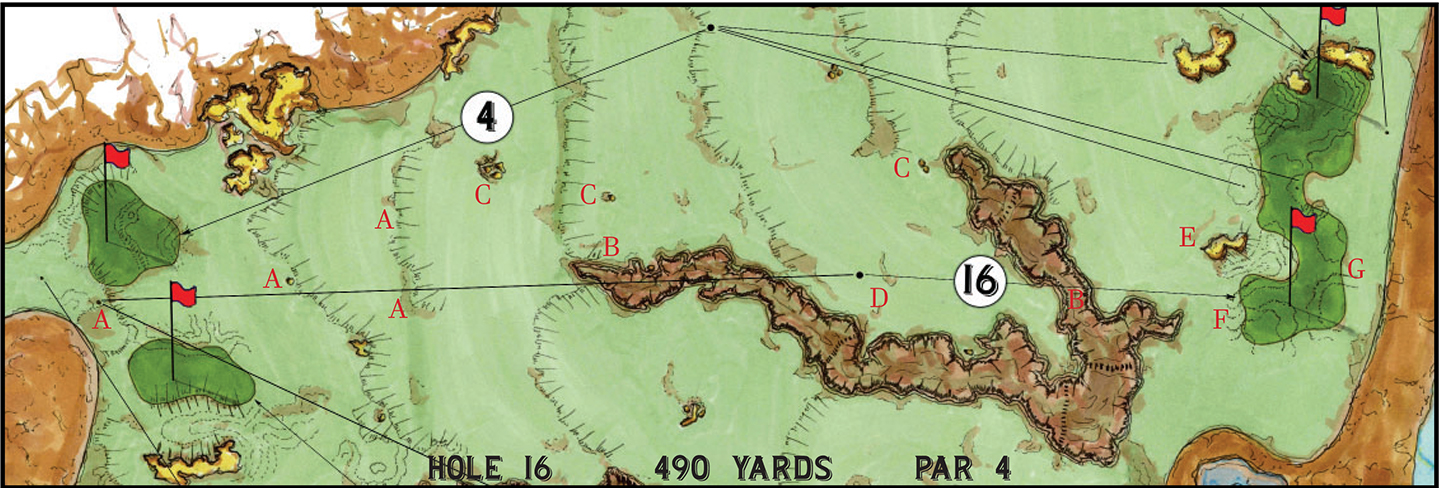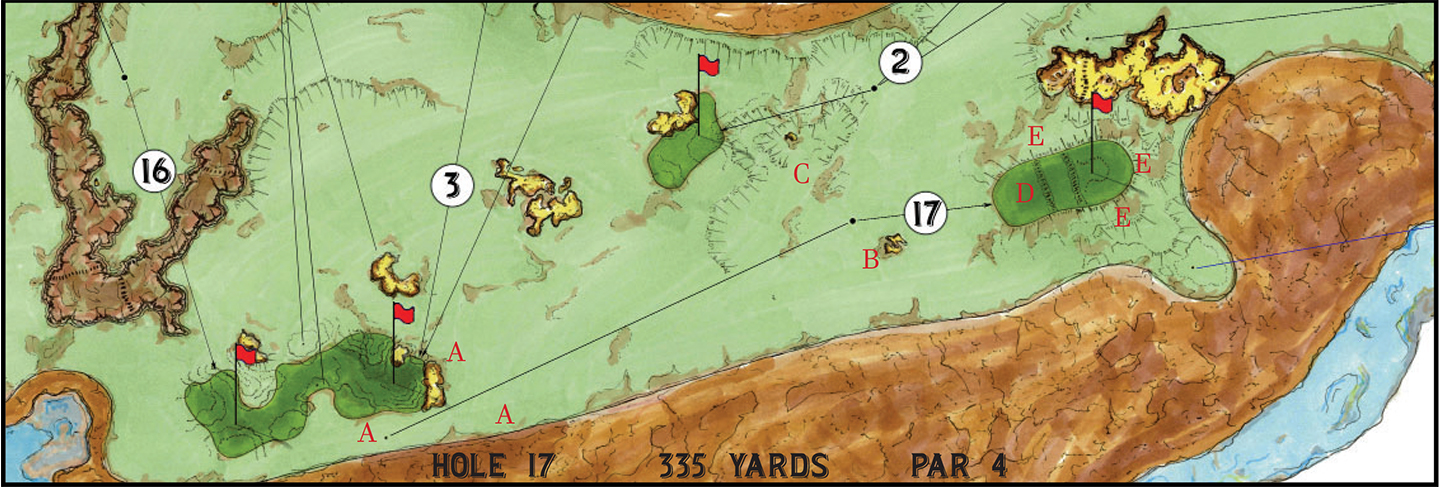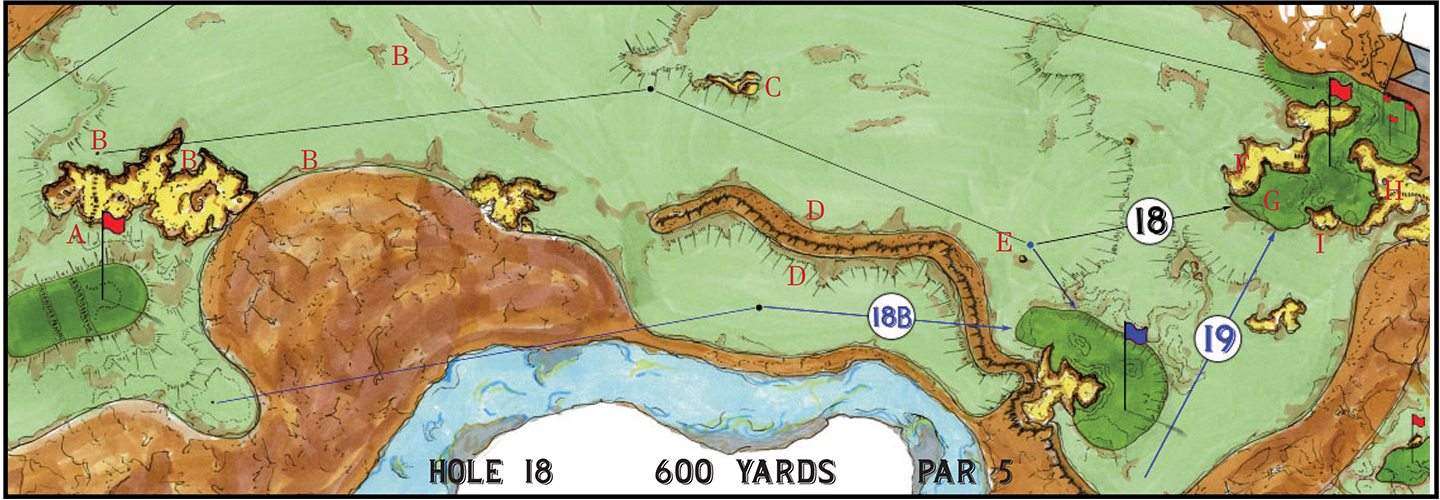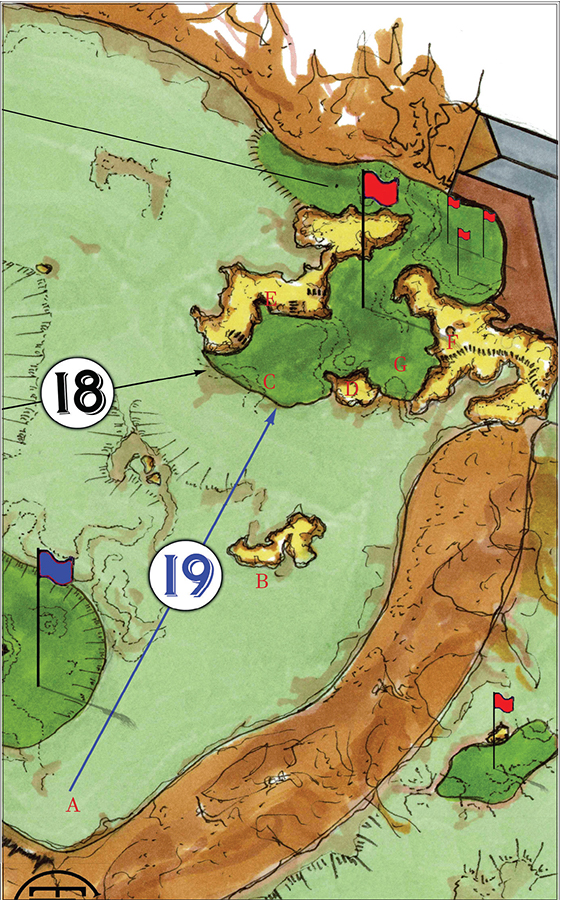Hole 1
Par 5530 Y
A. The clubhouse building shall be situated directly adjacent to the putting green, first tee, driving range tee, and home green These closely connected features and seamless transitions will create a hub of activity around the beginning and end of one’s round, and the resulting shared experiences common to this area will provide a precursor of what can be expected during one’s time at The Buck Club. From the commanding vantage point of the club porch, members can watch their friends and guests attempt to successfully navigate the opening tee shot and approach to the Home green.
B. The putting green shall tie in at grade to the patio of the clubhouse, a tight transition that will facilitate movement between the two while providing a welcoming atmosphere for members and their guests. The shaping and detail work of the putting surface and the surrounds will introduce players to many of the themes that they will encounter on the golf course, an important visual and physical reminder that one is poised to experience one of the world’s best layouts.
C. The back tee will be an extension of the putting green, and players who choose to use this teeing ground will be mere steps away from friends and guests when they strike their opening shot. Additional free-form teeing grounds will be shaped as an extension of the fairway at a variety of distances and angles. This style of tee will give players and the course set up crew nearly unlimited options in how the golf course plays from one day to the next.
D. The deep, artistically inspired serpentine bunker cutting a diagonal into the Home green will greet players as they hit their opening tee shots, thereby creating a profound sense of anticipation for what is to come over the next several hours.
E. The wide open fairway of the opening hole will allow players to ease into their round. The fairway itself gently tumbles downward from tee to green. Firm and fast conditioning will also give the fairways of The Buck Club a multi-colored hue, a visual reminder that the ground game is of paramount importance here.
F. A stern cluster of bunkers mark the spot from which one would ideally like to approach the green. Strategically placed but penal in nature, this group of hazards will exact a severe toll on anyone who mistakenly finds their depths.
G. The +/- 8,000 square foot boomerang putting surface will be open in front in order to accept all manner of approach shots from aerial to those running along rumpled ground. This green is the perfect introduction to the architectural concepts behind the The Buck Club. While players can access front and front left pins from most parts of the fairway, it will be up to the individual to decide which area constitutes the ideal angle of approach for his / her game. For instance, the central greenside bunker creates a strong contour that bleeds into the green, effectively creating a backstop for pins on the left side. Players approaching from the center and right side of the fairway may choose to utilize this feature to get the ball close, while those who approach from the far left side of the fairway may prefer to avoid the strong contour as they bring the ball in toward the hole. Fully understanding the pin location will also play
a key role in one’s success or failure in navigating the putting surfaces at The Buck Club. As the pin here moves toward the back and back right portions of the green, approaches from the left become increasingly difficult, while the cluster of bunkers in the approach enjoy the best angle to these pins. Aggressive players attempting to go for the green in two can also access pins in the back left by hugging the natural ground contours, which will allow balls to play away from the bunker while tracking along the ground in pursuit of a short eagle putt. Conversely, holding the green from the far left is an entirely aerial affair, with shots that must fly the raised central bunker and stop quickly on the shallow green, a prospect that will only reward the most perfectly struck shots.
H. Players who find the deep greenside pot bunker on approach will typically find that bogey or worse is the norm. Contours around the bunker will be carefully massaged in the field in order to allow clever players to feed balls to distant pins by going around the bunker. Additional side slopes will provide helpful backstops to some pins from certain areas of approach.
I. An infinite variety of recovery shots may be played from the tightly mown surrounds. Anything from a putter to a lob wedge will be common as players attempt to negotiate the humps, bumps, and swales surrounding the opening green.
J. A mix cool season native grasses will be planted in the out-rough areas. This blend will provide a natural texture and look to the course while creating a diverse home for wildlife. Maintenance of these areas will allow players to quickly find and advance their ball. One of the central goals of The Buck Club is to allow players of every class to experience a round of golf with no lost balls.
Hole 2
Par 4340 Y
A. The tees for the second hole shall be built directly adjacent to the first green. Typical of the teeing ground at The Buck Club, flat spots will be built into the fairway at a variety of distances and angles,
helping to lay the framework for endless shotmaking options and playing strategies.
B. A natural ridge, which runs along the right side of the hole juts at a perpendicular angle into the line of play for shots played from the middle and right-hand tee boxes. Mirroring the famous drive over
the Old Course Hotel on the seventeenth hole at Saint Andrews, players who successfully carry the ridge and access the far right side of the approach area will be rewarded with the best angle of approach.
C. Balls that carry the ridge will benefit from a forward kick toward the green, making this hole drivable under the right circumstances. The combination of firm and fast conditions and the altitude of
The Buck Club will entice many players to take the ultimate risk here. However, only perfectly played shots along this bold route will be rewarded, as the penalty for a misstep can lead to compounding
and costly mistakes.
D. A Valley of Sin contour will be carved into the approach that extends from approximately thirty yards short of the green to the front left edge of the putting surface. Should one’s ball be sucked into
its depths, the difficulty of recovery and approach shots will be compounded exponentially. From this angle, players will be approximately 6-8’ below the surface of the green, and they will be playing
across the central axis of the putting surface, thereby bringing the right hand bunker into play. A wide variety of shots from a putt to a high pitch will be possible from this area.
E. An extremely penal pot bunker will be built in the Valley of Sin. The contours surrounding the bunker will direct shots toward the nasty little pit, effectively making it play much larger than its
diminutive size. From here, bogey and far worse is a possibility.
F. The front of the green shall remain open, allowing running shots and bold drives to tumble onto the putting surface. One of the most interesting pins on the green will be on the small lobe that abuts
the greenside bunker. Some players may find that accessing this location is easiest from the far left side of the fairway, while others may find comfort in attempting to reach the sliver of fairway on the
right side of the Valley of Sin from the tee. Such is the dynamic at The Buck Club where a sense of discovery and fitting the course to one’s own game is the norm. Features such as these will keep play at The Buck Club fresh by rejecting monotony or repetition of any sort. Players must constantly battle and work to discover their own best way around the course. Since the course is designed to accommodate nearly unlimited playing strategies, the complexion of the layout from one day to the next will be forever in motion.
G. The greenside bunker will hug the right side of the green, complicating approaches from the far left side. Players must also be cognizant of the possibility that any shot not well struck from the bunker
will have the potential to leave the green and find the Valley of Sin, or far worse, the pot bunker short left of the green. In true Buck Club fashion, this hole may seem simple at first glance, but misplayed
shots can quickly lead to a situation that spirals out of control, leaving the player wondering how he/she turned a sure birdie opportunity into the dreaded ‘other’ score.
H. Ample room will be provided over the green. As all maintained turf, minus the greens, at The Buck Club will be tightly mown. It will be up to the player to decide the best possible method of recovery. Anything from a putter to a lob wedge will be common.
Hole 3
Par 3195 Y
A. The design of the third hole is modeled after the famed Eden Hole on the Old Course as Saint Andrews. The +/- 30,000 square foot double green shares space with the putting surface on the incoming sixteenth hole. Playing 195 yards from the back tees, players will be pleased to walk away with a par, knowing before they start that any misstep can be met with grave consequences. Additional teeing grounds at a variety of angles and distances will be shaped in to the fairway in order to accommodate golfers of all skill levels. Consistent with Alister MacKenzie’s description of the original, it will be possible to play the entire hole along the ground, an option for higher handicappers who want to avoid all trouble but would be satisfied with a difficult par or easy bogey. Conversely, the scratch player or pro in pursuit of a birdie must execute flawlessly, as the challenge of the hole amplifies the closer one gets to the green.
B. A low cluster of bunkers adds visual deception to the hole. Creative players will delight in punching low running shots over the top of the hazard while watching the ball disappear briefly only to reappear again in dogged pursuit of the narrow throat at the opening of the green.
C. The penal Shell Bunker comes into play and keeps players honest who attempt to use low running shots to access the putting surface. Any players who find this hazard on their first attempt will be happy to go to the fourth tee with a bogey.
D. Our recreation of the Hill Bunker bunker will be every bit as fearsome as the original. Up and downs from here will be few and far between.
E. The fronting Strath Bunker will collect indifferent shots while providing solid protection for pins tucked behind the hazard.
F. The original ultra-steep back slope, which was tragically modified on The Old Course several years ago, will be recreated here. Any putts from above the hole will be incredibly perilous, making a two-putt a cherished occurrence.
G. A bold false edge will guard the right side of the putting surface. Clever players who roll off the green below the steep front can recover with a well-judged putt or chip. Contours will be massaged in the field to allow expertly played shots to work around the Strath Bunker on recovery, thereby leaving players with a makeable short putt to salvage a respectable score on the hole.
Hole 4
Par 4495 Y
A. In line with the all important ebb and flow and sense of rhythm common to great golf courses, the fourth at The Buck Club provides a stern challenge before backing off during the upcoming stretch that includes several birdie holes in the middle of the front nine. This 4.5 par is a long, uphill two-shotter that will reward solid shotmaking and leave one immensely pleased with a score of par.
B. The fourth hole will be a player’s first introduction to the barrancas that span the lower portion of the property. These natural drainage swales, dotted with native grasses and drought resistant vegetation, will confront the golfer with their bold visual presence as well as their all important relationship to the strategic fabric of the holes in this portion of the property.
C. Randomly placed pot bunkers will be built into the seemingly endless expanses of fairway at The Buck Club. These little pits can exact a heavy toll on an unlucky or overly aggressive golfer. Most will give at least a 1/2 half shot penalty, others will take more. One of the great beauties of the their scattered nature is that they come into play at different times under different conditions for all classes of golfer. With shifting winds and changing conditions, bunkers that were not in play in the morning will find great relevance in the afternoon. This dynamic will add tremendous variety in approach that golfers must consider from round to round as they work to unravel the mysteries of the course.
D. A formidable bunker on the right side of the landing area challenges those who choose to play away from the barranca on the tee ball.
E. Bold, creative, and artistic bunkering will be carved into the natural hillside that borders the hole. These bunkers will be a primer for the style of hazard one will encounter on the ‘Upper 100’ section of the property.
F. The green on the fourteenth hole at Nairn provides the inspiration for the putting surface here. Open in front, well struck balls will be able to climb the bold false front. The green itself is bisected by a ridge, making it difficult to reach back pins. However, aggressive shots may find relief in the backstops along the back right and back left sides of the green.
G. The shaping along the back left side will climb and tie perfectly into the tee for the sixteenth hole, providing another prime example of the tight relationships between features and the key element of shared experiences at The Buck Club. Members and their guests will delight in watching others attempt shots that reside in the mind in both a past and future tense.
Hole 5
Par 4445 Y
A. If the first four holes at The Buck Club were a tease for what is to come, the fifth is a full immersion into the radical beauty of the architecture of the course. Tees shall be benched into the existing ridgeline adjacent to the fourth and tenth greens. Additional forward tees will be shaped into flat spots in the extended fairway.
B. Central bunkering along the right center of the fairway will provide a thrill for shorter hitters, as carrying this hazard can result in an ideal angle at the green if players take advantage of the downslope and extend the length of the their drive with a low running shot.
C. A nasty grouping of pot bunkers guard the ideal angle from which to approach the green.
D. Play from the far left and far right side of the fairway will be semi-blind to fully blind depending on the angle. Large, natural landforms pinch the landing area and obscure one’s view from the
fringes of the expansive fairway.
E. A narrow tongue of grass extends from the valley floor up toward the green and its bold surrounds. Any shots that do not fully climb the hill will roll back to bottom of the hill, leaving exasperated players with a chance to try the shot again.
F. Most punchbowl greens in the world of golf look great in a photograph but function poorly in a real world setting. Typically, balls fail to funnel off the sides of the punchowl with the vigor that the architect intended, forcing most shots to rest toward the edge of the green, while center pins remain out of reach. This dynamic holds true because the typical punchowl lacks the bold contours along the outside of the green that can funnel balls with purpose to any and all pin positions. At the Buck Club, clever players will have the opportunity to access all hole locations with the correct shot along the gathering sides.
G. The double punchbowl green is the boldest, by far, to this point on the course. After a testing, long par four on the previous hole, the far more friendly confines of this green complex are a welcome respite for golfers. The two tiered green is shaped into a natural punchbowl site with steep sides extending sharply upward from the sides and rear of the putting surface. Any shots within the bowl will funnel onto the +/- 10,000 square foot putting surface, with the key to scoring coming in finding the correct plateau. A natural 7-8’ rise, which will be incorporated into the final shaping on the hole, divides the green into two distinctive areas. Should one find his or herself in the wrong section, a stern but engaging challenge awaits. It will be imminently possible to utilize the side and back slopes to maneuver the ball so that it eventually lays dead at the hole for a spectacular two putt. Players will delight in unlocking the riddle of this remarkable, one-of-a-kind green complex.
H. Tight transitions to surrounding tees are the norm here. Players will have the opportunity to progress forward with the ‘traditional’ routing by moving to the sixth tee. Otherwise, groups may want to double back toward the clubhouse by playing toward 9 or 9B green, a small example of the unlimited sense of discovery that awaits members and their guests at The Buck Club.
Hole 6
Par 4425 Y
A. The climb from the fifth green to the sixth tee begins the move into the Upper 100 in earnest. Players have multiple tee boxes from which to choose, but the task remains the same from each: play as close to the crest of the hill along the right side as possible for the best angle and view of the Sitwell green, the largest and most heavily contoured putting surface in the United States.
B. A massive cluster of bunkers, surrounded in native grasses and benched into the side of a natural ridgeline, encroach into the left side of the fairway. Avoiding these menacing pits will be essential if one expects to find success on the hole.
C. The closer one plays to the bunkering along the far right side of the fairway, the better the angle to the green. From this vantage point, the fairway falls steeply toward the green. Shots well short of this section of the fairway will be either semi-blind or fully blind on approach. Both distance and accuracy are required for the best views of the putting surface.
D. The narrow fairway chute falls steeply toward the entrance to the green. From the top of the hill, seemingly endless variety of shotmaking options abound, including the opportunity to putt to the green from over one hundred yards out. The variety of options at The Buck Club and the ever-present opportunity for heroic glory will provide endless entertainment and a bottomless depth to one’s sense of discovery here.
E. One’s first viewing of the nearly acre size Sitwell green, which is patterned after MacKenzie’s famed twelfth at Sitwell Park, will be a moment no golfer will ever forget. Some have attempted loosely inspired recreations in the past, but only The Buck Club will bring the full glory of MacKenzie’s original vision to fruition. Built into a natural rise, the +/- 40,000 square foot green will be climb nearly twenty vertical feet from bottom to top and will feature a series of plateaus that are broken up by massive rolls, ridges, and swales. It will certainly be possible to putt from one section to another, but the key to scoring will be in leaving oneself a manageable two putt. Profound attention to detail will be paid in the field work to ensure that playability remains at the forefront in spite of the severity of the green. Truly a hole that will shift from one day to the next, the sixth will offer a level of variety that only a few holes in the world can match.
F. The prudent play on many hole locations will be to favor the high left side in an effort to let the ball funnel toward the pin.
G. Endless width to the right of the green will allow players to bail out below the hole, thereby increasing the odds of recovery, as the difficulty increases exponentially the farther above the hole the approach comes to rest.
Hole 6.5
Par 3100 Y
A. Hole 6.5 is a player’s first introduction to alternate holes at The Buck Club. This short one-shotter tees off from a small flat spot to the left of the Sitwell green. Some players may choose to take the brief walk to the seventh tee, while others may delight in the challenge of an extra hole. Those who do accept the test will be confronted with an uphill shot where a great premium is placed on accuracy, in the mold of all great short par threes.
B. Shots toward the green will traverse the hillside, which will be dotted with bold bunkering and native grasses.
C. The front of the +/- 4,000 square foot green will be open in front. The remainder of the putting surface is placed on a diagonal between two bunkers. The green surface itself is carved into a natural half-pipe feature that helps balls funnel toward the middle of the green Additionally, clever players will have the opportunity to maneuver balls along the ground to putt near hole locations not directly accessible by a straight line. Curving balls around bunkers and off of side slopes will create a never-ending source of amusement for members and their guests.
D. A deep fronting bunker will create indecision and intimidation on the tee shot. Bogey from this position would be a welcome score.
E. The semi-boomerang, half-pipe putting surface nestles perfectly into an existing swale. Shots in and around this green will be some of the most entertaining on the course.
F. A bold visual presence, the climbing bunker behind the putting surface doubles as a greenside bunker for the fourteenth, which sits 7-10’ above the green for 6.5. This stacked layering of features will not only create a bold visual, but it will also be a hub of activity for players as they navigate the early and late stretch of their rounds.
G. Players standing on the fourteenth green will have a commanding view of incoming shots on 6.5, and their presence will help create an amphitheater-like effect for players attempting to navigate the challenges of this devilish short hole.
Hole 7
Par 4390 Y
A. The tees of the seventh, which sit near the top of the property, enjoy commanding views of the Upper 100 and the valley section of the property. One of the most eclectic and varied teeing grounds on the course, a series of tees is benched into the hillside and are surrounded by the highly artistic native bunkering in this section of the property. Rustic, wooden stairs that meander through the native areas will be built in order to connect the tee boxes to the adjacent fairways.
B. From the tee, players will have the choice of how much bunkering to attempt to cut off on their opening shot on this traditional cape hole, with more aggressive tee balls having an opportunity to run all of the way to the green. The bunkers in this section of the property will be cut into an existing, steep ridgeline that is an average of +/- 20’ deep. These highly distinctive and outrageously bold bunkers will be yet another strong signal to players that they are experiencing one of the world’s most unique and thrilling layouts.
C. The existing natural declination will be massaged into a series of rolls and contours that help direct well placed tee balls toward the green surface. Any tee shots that hang up in this area can be played entirely along the ground toward the green. How well one manages the challenge of the ground at The Buck Club will be a central part of one’s story after the round is over. Correctly judging the slopes of the ground and the speed of the lightning fast turf will be a an aspect of the beguiling golf here that never ceases to entertain.
D. The throat in front of the green will dive sharply down toward the green surface, ensuring that balls run out and onto the green from this area. Correctly judging the speed and direction of the ball on approach will be central to one’s success or failure here.
E. The +/- 10,000 square foot green will accept running shots from the ideal angle of approach, and the fall-away contours will be massaged in the field so as to ensure that well played shots are rewarded. The green itself will be shaped on the edge of an existing precipice, thereby giving it an infinity look from the fairway.
G. Ample bailout area will be provided over the green. However, shots from this area will need to contend with a steep uphill climb back up to the green surface.
Hole 8
Par 3235 Y
A. The Mega Redan at The Buck Club is destined to become one of the best and most notorious versions of the famed template. When inspecting a piece of property during the routing phase, there are some holes that cannot be denied. In the case of The Buck Club, the routing of the course has gone through many iterations, but one of the few constants in every version is the Redan in this section of the property. The tees sit on a shelf +/- 15’ below the surface of the previous green. With a steep drop to the valley section of the property along the left side, the teeing ground has commanding views of the surrounding terrain while lending players a sense of purpose as they anticipate the all-important long iron or wood approach. Additional forward tees will be shaped to accommodate golfers of all skill levels.
B. The traditional short bunker on the Redan will be shaped into the existing ridgeline approximately forty yards short of the green.
C. The soon-to-be-famous ‘Milk Carton Bunker’ will be shaped into the face of the ridge along the left side of the green surface. The depth of this hazard will extend up to thirty feet below the surface of the green, immediately earning the reputation as a hazard that one may not return from once they enter.
D. Given the severity of the traditional left-hand diagonal bunker, the prudent play will always be to aim toward the mega kicker on the right side of the green. Well played shots will trundle down the slope and sharply to the left in pursuit of the pin. The thrill of watching one’s ball climb the hill to the right of the green before it turns hard left on its way to the putting surface will never cease to entertain members and their guests.
E. Seamless tie-ins to the ninth tee and the fairway on the sixth help blur the lines between playing corridors.
F. The massive +/- 15,000 square foot green tilts sharply from front right to back left. In the manner of the best redan holes in the world, balls can be fed along the ground the entire length of the green in order to reach the most daunting pin on the green, the far left hole location.
G. The traditional rear bunker here ties into the tee shaping on the sixth and ninth holes.
H. Carelessly played shots that run through the green will be punished by the fact that they will end up in the throat of the approach for the fifth hole, with the result being that most balls will roll all the way to the bottom of the hill, a position from which recovery is far from certain.
Hole 9
Par 3150 Y
A. After a short walk from the eighth green that brings the one past the double punchbowl, players climb the hill to a tee perched above the fifth green. From here, players have panoramic views of nearly the entire property. As play continues behind on the double punchbowl and The Redan, one must focus their attention on the task at hand: hitting a short iron safely on the double thumb-print, which is built into an island in the middle of the barranca. While the +/- 12,000 square foot putting surface is an ample target, the visual intimidation inherent in this short, downhill shot will rattle even the most seasoned players. In line with the best short holes in the world of golf, good shots are rewarded and indifferent efforts are expelled with potentially catastrophic consequences for one’s scorecard.
B. An artistically rendered strip bunker, which, from the eighth tee, appears to border The Redan, ties into the shaping underneath the tee box. It also doubles as a visually intimidating feature on the fifth hole and is a most unwelcome resting spot for poorly played shots coming into the double punchbowl. Again, we see that the lines between the holes at The Buck Club are blurred, thereby reinforcing the reality that one is exploring a vast, uninterrupted golfing playground.
C. Players will traverse the native areas on a series of hand crafted, wooden walkways.
D. The floor of the unmaintained barranca, which sits an average of 5-10’ below the surface of the green, will be a place where one can always find and advance the golf ball, but the prospects for success will vary depending upon the all-important matter of rub-of-the-green. How one’s ball comes to rest in the barranca, and the degree to which on will regret being there, will be a fickle matter left entirely up to the whims of the golf gods.
E. Rugged, artistically rendered bunkers shall climb out of the barranca floor and toward the green edge. In a nod to the brilliant Short hole at National Golf Links of America, a section of the left-hand bunker will a mere strip. Any shots that find this fearsome pit will almost certainly face the equivalent of a one stroke penalty at bare minimum.
F. The double thumb-print green will reward well struck iron shots. Anyone finding the correct section of the green on approach will have an excellent look at birdie, while traversing from one area of the putting surface to another will bring a challenge that is usually only manageable with two well played putts.
G. Another perfectly executed tight transition will bring golfers to the primary tenth tee, which shall be shaped into the island on the opposite side of the rear bunker from the green surface.
Hole 9B
Par 4350/410 Y
A. 9B would be the best hole on most courses. At The Buck Club, its an alternate hole that you may or may not experience during your round. A teeing ground behind the eighth green, which doubles as a tee for the sixth, can be utilized here. The traditional ninth tee near the fifth green may also be used for this hole. Playing sharply downhill, players will have a sense of confidence on the tee. The knowledge that clearing the barranca will lead to the best possible score will encourage many to pound a driver, but the prudent play is to weight accuracy in greater measure than distance.
B. The Barranca provides a daunting visual challenge on the tee shot. A sliver of the barranca shall jut into the hole near the preferred angle of attack at a 90 degree angle to the line of play.
C. A deep trench bunker will be built into the edge of the barranca. Any golfers who wind up here will find par to be a very difficult score to attain. The closer one plays to this feature, the better their angle of approach to the green.
D. Additional central bunkering in the right center of the fairway will create interest and challenge for those who bail out too far to the right on the tee shot.
E. The green, which is angled to most readily accept shots from the left side of the fairway, will be open in the front, with the entrance tying in at grade to the fairway approach. As a result, the smart play on many occasions will be to run the ball onto the green with a low running shot. The putting surface itself will kick up along the back edge the green, thereby helping running shots to trace along the ground in pursuit of middle and back right pins. Gentle rolls within the putting surface will break up the middle portion of the green, while allowing clever players to use contour to access certain pins near the edge.
F. A deep central bunker will eat into the middle of the green. While the pit of sand is not directly adjacent to the green surface, the surrounding contours will help direct balls to its depths. Aggressive play that flirts with the edge of the green will need to be deadly accurate in order to avoid the misfortune of watching your ball get sucked into the recessed hazard, which will be approximately 8-10’ below the green’s edge.
F. Ample room surrounding the green will accommodate all manner of recovery shots. The primary challenge for balls hit over the green will be in negotiating the steep pitch back up to the putting surface, with the primary fear being that balls played with too much pace could wind up in the greenside bunker, thereby leading to a compounding scoring disaster.
Hole 10
Par 4460 Y
A. Whether just finishing 9 or 9B, a teeing ground will be steps from the previous green. The tee near the ninth green will be physically separated from the putting surface by the deep rear bunker. A small walkway provides access from the green to the tee, another carefully considered artistic feature that provides all-important texture and character to the layout. While not as dramatic of a transition, the walk from 9B to the tenth tee is a matter of a few steps, a reminder of the intimacy of the layout and the importance of symbiotic features. Additional forward tees will be built in small nooks adjacent to the barranca.
B. The weaving barranca plays a major role in the strategic fabric of the golf hole. A narrow sliver along the right guards the far edge of the fairway near the ideal location from which to approach the green.
C. Small pot bunkers dot the landing area. Anyone unlucky enough to find these will struggle mightily to make par, and the reality of a big number enters the equation once one is forced to play from them.
D. Play from the safe, left side of the fairway will be complicated by the angle of approach to the green, which is shallow from this position. Additionally, the bunker near the green appears to be greenside from this location, but in reality is approximately 15-20 yards from the putting surface. This visual deception and the semi-blind nature of the shot will increase the difficulty of approaches form here.
E. This bunker, which has a parallel axis to that of the green, determines much of the strategy on the hole. As the back lip of the bunker is raised above the elevation at the edge of the green, play from short of the bunker will be extremely deceptive, and anyone unlucky enough to find the actual hazard will struggle mightily to keep the ball on the domed green.
F. A deep swale between the bunker and the green can wreak havoc on approach shots. Any pulled shots from the ideal angle of attack will likely end up here, while play from the left side of the fairway will see many balls come to rest in this location. From beneath the surface of the green, players will face a tough decision of whether to chip or putt. In many instances, play along the ground will be the safest option, but any fainthearted recovery shots will see players being forced to hit the same shot twice after the ball rolls back to their feet. Conversely, one will need to guard against the possibility of hitting through the green to the other side. Such is life at The Buck Club where challenges increase exponentially the closer one gets to the green.
G. The narrow green shall be slightly domed with fall-offs along both the right and left side. These contours, when combined with the tightly mown turf, can exact a serious toll on any indifferent efforts.
H. When playing a recovery shot from the right side of the green, one will need to guard against an overzealous effort that finds one’s next shot in the swale on the left. The ever-present psychological battle to avoid a worst case scenario must be won here if success is to be found on the understated, but ever-beguiling, tenth.
Hole 11
Par 5515 Y
A. The back tee for The Road Hole shall be situated on a flat spot between the tenth and fourth greens and will be revisited when teeing off on the sixteenth. Additional flat spots will be shaped into the fairway for forward teeing grounds.
B. At The Buck Club, the barranca along the right side of the hole takes the place of the Old Course Hotel on the original Road Hole. Players who successfully challenge the diagonal of the barranca and find the far right side of the fairway will be rewarded with the best angle of approach to the green.
C. The all important Scholar’s and Progressing Bunkers shall be built in their traditional location short and left of the green. These hazards keep players honest who choose to avoid the challenging line of charm along the right. Additionally, some players may choose to play the hole as a three-shotter when the pin is located on the far left portion of the putting surface. In this instance, golfers will need to seriously challenge Scholar’s and Progressing when attacking the approach left of the Road Bunker.
D. To the best of our abilities, the contouring and angle of the original Road Hole green will be recreated here. A bold false edge on the right side ties in at grade and provides a serious challenge on approach. Along the back edge of the green, a steep fall off ensures that only perfectly angled and played shots will remain on the green. The far left side of The Buck Club version will wrap around the greenside bunker with a false edge that provides interest and demands precision on approach and recovery.
E. The famed Road Hole Bunker eats into the center of the green, striking the ultimate fear into golfers on approach to the green. Of all bad spots in which to find oneself, this is perhaps the worst, given that bogey and far worse immediately become a possibility should one’s ball come to rest here.
F. Recovery from over the green will require great precision as shots not struck hard enough will return to the golfer’s feet, while balls with too much steam can go through the front of the green, or worse, into the Road Hole Bunker. A perfect half par hole, the eleventh gives players the opportunity to revel in the possibility of reveling in the glory of a hard-earned par while trying to avoid the disastrous big number.
Hole 12
Par 4475 Y
A. Another stout par four, the twelfth hole gives players a multitude of options on the drive, approach, and in recovery situations. Tees for the hole will be built adjacent to 9B green, with forward teeing grounds shaped into the left and right side of the fairway. Playing strategies will be primarily dictated by the pin location on the “Double Platbowl” green, which is inspired by Andy Johnson’s entry for the 2018 Lido Prize competition.
B. Bold golfers who choose to attack pin locations on the right side of the green will feel inspired to directly take on the barranca on their drive in an effort to reach the right fairway.
C. The landing area along the right side of the barranca is wider than it looks from the tee. Players who successfully reach this zone will find an open approach to pins located along the right side of the heavily contoured putting surface.
D. One of the wonderful aspects of the playing strategies of this hole is that it truly accommodates golfers of all skill levels. Play along the uninterrupted swath of turf along the left side that avoids any forced carries is entirely possible, and may be preferable for weaker golfers even when they are playing to right-hand hole locations. Using this strategy, a relatively easy bogey should be expected, with the primary benefit being that the probability of a big number has been reduced. The hole really shows its teeth when players attempt to go for birdie but fail to execute, thereby leaving themselves in a position where double bogey or worse is highly possible. This is the key essence of much of the architecture at The Buck Club. Players can assess their own risk appetite and act accordingly, but when one really wants to score, execution is of paramount importance because the potential for disaster is lurking, a fact that the recesses of the mind all too readily acknowledge.
E. A thin line of barranca extends down the fairway, bisecting the hole, directly in line with the heart of the green. Players who have the misfortune of finding themselves in the barranca will always be able to find the ball, but they may not like their lie, a rub-of-the-green dynamic that will play a large role in determining one’s success or failure.
F. A line of deep, artistic bunkers will be carved into the swale that bleeds out of the barranca, a la Pasatiempo. The bunkers terminate directly in the center of the green, which is the dividing line between the right and left ‘platbowl’.
G. The green, which wraps around the greenside bunker, contains two separate plateaus on the right and left side which are actually self-contained punchbowls. The rear of the green rises sharply and allows the clever player to utilize the strong contour to play from one side of the green to the other on a long, curving line that avoids the central hazard but keeps alive the possibility of getting down in two. Innumerable shot combinations will be possible on this putting surface depending on one’s angle of approach, hole location, appetite for risk, and imagination.
H. A bold cluster of bunkers, built into a natural rise, separate the green complex from the tees for the thirteenth hole.
Hole 13
Par 5510 Y
A. After back-to-back difficult par fours, golfers will are presented with a genuine scoring opportunity on the thirteenth. A short walk up a handmade staircase cut in amongst the bunkering delivers the player to the teeing ground.
B. From the teeing ground, players will have an important decision to make: hit straightaway, leaving a blind second shot but an easy wedge over the bunker wall or take on the line of hazards off the tee, a feat when successfully attained, will allow one to have an open run at the green on their second shot.
C. A +/- 20’ steep natural rise bisects the golf hole into which the most fearsome bunkers on the golf course will be built. Several staircases built into and around the hazards will ferry players from the lower to upper fairways. Set on a diagonal, carrying the hazards on the tee shot will provide an uncommon thrill, while finding their depths can ultimately require multiple shots in order to escape.
D. Players who choose not to attack the bunker wall on the tee shot will ideally want to access the end of the fairway, which will leave a simple short iron up and over to the upper fairway. While reaching the green from this position is not impossible, it may be the riskiest shot on the golf course. As such, layups will be the most common route from here.
E. Approximately three hundred yards from the tee, the optimal place from which to play the second shot is safely atop the bunker wall with a direct line at the green. From here, the golf course can yield an eagle with accurate play.
F. Earlier iterations of the routing had a short, postage stamp hole with a tiny green located in this spot. Built into a natural shelf, this site is screaming for an all-world 1,500-2,000 square foot green surrounded by bunkers. As such, the decision was made to build the green, making it a reality that can be incorporated into the unlimited number of cross country routings found at The Buck Club. One such routing would see players playing the thirteenth as a par four to this alternate green. Ultimately, though, members and their guests will only be limited in the number of ways to unlock this playground by their own imagination.
G. Bunkering will be built in the area short of the green from which one would ideally prefer to play their third shot. This hazard forces players to carefully consider whether or not a layup shot is the prudent play. If a layup is in the cards, careful consideration must be given to the shot, as blindly wailing away could lead to an unwelcome result.
H. A +/- 40’ cliff borders the left side of the second half of the hole. Playing safely away from this feature will be essential to success here.
I. A 3-5’ roll will be built at the entrance along the right side of the green. Maintained at fairway height, this devilish feature will potentially wreak havoc on players who choose the safe, far right side of the hole on approach. While it will be possible to negotiate this feature with anything from a putter to a lob wedge, players will need to summon great precision to avoid finding themselves in an awkward position on their subsequent shot.
J. Open in front, the green is bordered on the left by a cliff. Players will delight in running shots onto the green in an effort to access the most difficult pins by using the contours of the ground.
K. Bunkers that climb out of the bordering cliff will protect the front left and rear of the green, with the rear bunker flashing up dramatically into the fourteenth tee.
Hole 14
Par 3175 Y
A. After back-to-back difficult par fours, golfers will are presented with a genuine scoring opportunity on the thirteenth. A short walk up a handmade staircase cut in amongst the bunkering delivers the player to the teeing ground.
B. From the teeing ground, players will have an important decision to make: hit straightaway, leaving a blind second shot but an easy wedge over the bunker wall or take on the line of hazards off the tee, a feat when successfully attained, will allow one to have an open run at the green on their second shot.
C. A +/- 20’ steep natural rise bisects the golf hole into which the most fearsome bunkers on the golf course will be built. Several staircases built into and around the hazards will ferry players from the lower to upper fairways. Set on a diagonal, carrying the hazards on the tee shot will provide an uncommon thrill, while finding their depths can ultimately require multiple shots in order to escape.
D. Players who choose not to attack the bunker wall on the tee shot will ideally want to access the end of the fairway, which will leave a simple short iron up and over to the upper fairway. While reaching the green from this position is not impossible, it may be the riskiest shot on the golf course. As such, layups will be the most common route from here.
E. Approximately three hundred yards from the tee, the optimal place from which to play the second shot is safely atop the bunker wall with a direct line at the green. From here, the golf course can yield an eagle with accurate play.
F. Earlier iterations of the routing had a short, postage stamp hole with a tiny green located in this spot. Built into a natural shelf, this site is screaming for an all-world 1,500-2,000 square foot green surrounded by bunkers. As such, the decision was made to build the green, making it a reality that can be incorporated into the unlimited number of cross country routings found at The Buck Club. One such routing would see players playing the thirteenth as a par four to this alternate green. Ultimately, though, members and their guests will only be limited in the number of ways to unlock this playground by their own imagination.
G. Bunkering will be built in the area short of the green from which one would ideally prefer to play their third shot. This hazard forces players to carefully consider whether or not a layup shot is the prudent play. If a layup is in the cards, careful consideration must be given to the shot, as blindly wailing away could lead to an unwelcome result.
H. A +/- 40’ cliff borders the left side of the second half of the hole. Playing safely away from this feature will be essential to success here.
I. A 3-5’ roll will be built at the entrance along the right side of the green. Maintained at fairway height, this devilish feature will potentially wreak havoc on players who choose the safe, far right side of the hole on approach. While it will be possible to negotiate this feature with anything from a putter to a lob wedge, players will need to summon great precision to avoid finding themselves in an awkward position on their subsequent shot.
J. Open in front, the green is bordered on the left by a cliff. Players will delight in running shots onto the green in an effort to access the most difficult pins by using the contours of the ground.
K. Bunkers that climb out of the bordering cliff will protect the front left and rear of the green, with the rear bunker flashing up dramatically into the fourteenth tee.
Hole 15
Par 4560 Y
A. The primary tee will be shaped a few paces off the back of the fourteenth green. Perhaps the grandest hole on the course, the fifteenth starts at the highest point of the course and sweeps dramatically downward toward the valley section of the property after traversing 560 yards of the Upper 100. While a par four of this length may seem excessive on the card, the hole plays much shorter than actual length given the steep downhill nature of the terrain combined with the firm turf at elevation. Additional forward teeing grounds will be shaped into the fairway, thereby making the fifteenth a manageable hole for golfers of all skill levels.
B. The largest single bunker on the golf course, which extends over one hundred yards in length, bisects the massive expanse of fairway. Several handmade wooden walkways will be built into the bunker, giving it additional texture and feel.
C. Pot bunkers shall be scattered about the landing area. While small in size, these pits will have a profound impact on one’s thinking while on the tee and on the approach, especially for those who fail to hit a good drive.
D. Approximately 100 yards short of the green, a bold cross hazard will be shaped along the ideal line of play. Players will delight in watching their ball disappear over the bunker only to reappear in the throat of the approach as it tracks toward the hole.
E. The ground short of the green slopes steeply toward the putting surface. All manner of approach shots will be common here, but the running approach will be the most beguiling, interesting, and ever-changing option, which will very depending upon one’s location on approach, the day’s conditions, and the golfer’s level of confidence in hitting the required shot.
F. Mounds reminiscent of those on the eighth hole at Augusta National will be built on either side of the green. They will complicate matters for golfers who find themselves out of position on the far right side of the fairway, while at the same time providing all-important containment for balls running hot on approach. Along the left side, the mounds will tie perfectly into the existing ridgeline.
G. The large, +/- 12,000 square foot fall-away, infinity green will tie in perfectly with its natural surrounds. Attempting to hit thrilling running shots to the rear pins will be an endeavor of which members and their guests will never tire, and the finish work on and around the green will ensure that these shots are can be executed.
H. Ample room for play will be provided over the green for golfers who run through the putting surface on approach.
Hole 16
Par 4490 Y
A. Players return to the teeing ground that they previously visited on the eleventh. Playing downhill across the valley floor, the sixteenth is a strong, strategic par four that requires well-planned shotmaking in order to achieve success. A number of forward tees will be shaped on flat spots in the fairway, giving the course set up crew great latitude in how to present the hole from on day to the next.
B. The long finger of barranca that extends from the valley floor up the incline in the direction of the tee will create a strategic dilemma on the tee shot. The best angle of approach is afforded to those who play close to the hazard off of the tee. Additional emphasis is placed on the tee shot given that the barranca cuts at a ninety degree angle across the line of play +/- 40 yards short of the green. Those who fail to hit a solid ball off of the tee will be faced with a touch decision: risk taking on the barranca in an effort to get to the green or lay up short in the hope that an up and down can be achieved.
C. Pot bunkers that came into play on the fourth will once again find relevance here.
D. The optimal location from which to hit the approach, players who find the right side of the fairway near the barranca can avoid traversing the greenside bunker on approach.
E. The greenside bunker, which does not directly abut the putting surface, is a hazard that appears to be greenside from the left side of the approach. A strong fronting contour in the middle of the green hides a portion of the putting surface from the fairway. It is into this roll that the bunker is built, lending it its deceptive appearance. The amount of visual deception and shotmaking difficulty is amplified the farther left one plays off the tee. From the far right, the green is open and the fronting contour can actually be used to help funnel balls toward certain pin locations, whereas approaches from the left must not only carry the bunker but must be hit the proper distance lest their shot be repelled by the contour.
F. The massive sixteenth green, which shares space with the third, is open on the right side, encouraging players to attempt the run up shot. At +/- 30,000 square feet, the combined putting surface contains an extremely wide variety of potential pins. One’s strategy and approach to the hole must be tweaked with each new location for the best possible chance of success here. Pins tucked behind the bunker and fronting contour will be the most difficult. When the pin is in this area, some may still opt to play for the right side in the hopes that a long two putt is in order.
G. Recovery room is provided over the green. Mown entirely as tight fairway cut, the prudent play will usually be to keep the ball on the ground. From here, the strong contour at the entrance to the green can act as a backstop, which will aid many in their effort to get up and down.
Hole 17
Par 4335 Y
A. Perfectly placed in the progression of holes for match play, the gambling, drivable seventeenth is a strategic and shotmaking gem that will determine the outcome of many a match. The tees will be scattered about in the area directly adjacent to the third and sixteenth greens, giving golfers an opportunity to play the hole from a variety of distances and angles. With the wind at one’s back, the hole is imminently reachable given the firmness of the turf and the open and accepting nature of the front portion of the green.
B. Several nasty and fully penal bunkers will be shaped approximately thirty yards short of the entrance to the green. Players who choose to make a run at the green from the tee must give careful consideration to these hazards before striking the ball, as they will be constructed in such a way as bring about the possibility that more than one shot will commonly be required to escape. Should players fly or skirt by them, they will be on a direct line to the pin with a chance to make a late eagle, an enticing way to secure
victory in a hard fought match.
C. Play to the safe side of the wide fairway will result in an angle of a attack that forces the golfer to play across the central axis of the green. Every degree farther away from the line of charm one plays will lead to an incrementally increased level of difficulty on the second shot.
D. The +/- 12,000 square foot Biarritz green is open in front and ties in at grade to the approach. A +/- 6’ deep trench bisects the front and back plateaus of the green. At The Buck Club, the traditional rear back plateau, which will see most of the pins, will be constructed with a thumbprint contour.
E. While the front of the green may tie in at grade to the approach, the green falls away along the sides and rear of the green. The depth of the surrounds in relation to the surface of the green becomes more pronounced the closer the ball gets to the back of the green, thereby compounding the penalty for a miss on an aggressive approach shot. Recovery from these areas will require a deft touch and can be executed with anything from a putter to a lob wedge. A thoroughly tantalizing hole, the seventeenth will alter-
natively tempt, reward, and decimate the hopes of members and their guests.
Hole 18
Par 5600 Y
A. A massive bunker will be carved into the existing hillside on the left side of the seventeenth green. The final green to tee transition on the traditional layout will see golfers using the steps built into the face of the +/- 20’ deep bunker access the tees on the Home hole, a gambling risk/reward three shotter, which is the perfect way to end a course designed and built to support and promote the superior form of golf, match play.
B. The primary rear tee will be incorporated into the shaping of the bunker. Additional forward tees will be built both adjacent to the bunker and in flat spots in the nearly two hundred yard wide expanse of fairway.
C. Central bunkering will built in the ideal spot from which to play one’s second shot. Playing slightly to the right of this feature will provide a good look at the green while minimizing the impact of the +/- 20’ drop-off that borders the right side of the landing area.
D. A natural, sharp ridge with a +/- 20’ drop guards the right side of the hole. Avoiding this feature will be a key to finding success on the last hole of the traditional routing. Should one’s ball drop to the lower fairway, a blind shot will be required on the next effort to get back to the proper level.
E. A minuscule pot bunker will occupy a patch of ground near the ideal layup spot for one’s final approach to the green. While diminutive in size, this nasty little hazard could ruin one’s hopes of success in their match.
F. The menacing greenside bunker that provided much of one’s introduction to The Buck Club, eats into the left side of the perfectly angled Home green.
G. From the correct angle of approach, it will be possible to run one’s ball onto the green while avoiding the bunker. The green climbs steadily from the entrance via a series of natural rolls and ridges to its high point near the putting green where it pinches to a few yards wide. The multitude of hole locations and artistically rendered contours and surrounding features will ensure that the challenge and pleasurable excitement provided by the Home hole will never grow stale.
H. The equally frightening rear bunker keeps players honest on approach. While not always visible from the fairway, seasoned players will give it the respect it demands on their final full shot of the day.
I. Resembling the famed Devil’s Asshole at Pine Valley, this small bunker commands one’s attention and must be avoided at all costs should a successful resolution to one’s round be in the cards.
Hole 18B
Par 5510 Y
A. As if the previous twenty holes didn’t provide enough variety and excitement, players at The Buck Club will be given the opportunity to play an entirely separate eighteenth hole. 18B is a difficult test as a long par four with a split fairway and a multitude of options from tee to green. Players will have several options to consider when selecting a teeing ground. It is possible to play the hole from a flat spot near the seventeenth green or from the more traditional tee box atop the bunker adjacent to that putting surface.
B. A diagonal carry over the native area will dictate just how aggressive a player wants to be on the tee. Sound driving is essential if you choose to take the short route home.
C. A highly visual carry bunker comes into play primarily for players on the upper tee who are aiming at the lower fairway. Nonetheless, it is a dramatic feature which will command one’s attention on the tee box.
D. The longer upper route to the green is the safest way to play the hole, but this route is substantially longer than the number listed on the card. Many players using this route will aspire for a tough par and an easy bogey.
E. For players who choose the aggressive play along the lower fairway, they will be forced to contend with the +/- 20’ wall that delineates the upper and lower fairways. The trade-off, of course, is that this is a more direct and shorter route to the hole.
F. Reminiscent of the raw and distinctive bunkering that climbs out of the face of the cliff in front of the eighteenth green at Pasatiempo, this bold hazard will simultaneously seduce the mind of and strike fear into the heart of the golfer.
G. One of the largest greens on the course, 18B is no afterthought at +/- 18,000 square feet. This massive green hooks around the fronting bunker, encouraging low runners for players coming in from the left. Golfers coming directly into the green from down below will benefit from a strong punchbowl contour that extends along the back edge of the green. Internal rolls and false edges along the far reaches of the green will provide grounds upon which endless shotmaking opportunities and options will unfold.
H. Players who find themselves over the green will have a number of options, but the tricky rear contour could wreak havoc when one tries to regain their position. Once again, the tightly mown turf will welcome all manner of shots along the ground. Aggressive players with a deep confidence in their short game may want to flop it over the punchbowl and onto the green surface. Par will always be a welcome score here, with a heroic birdie being the deciding factor in many matches.
Hole 19
Par 3120 Y
A. Just in case your match didn’t wrap up after the eighteenth, the nineteenth hole is here to settle all bets and/or provide one last gasp of fun and intrigue. At only 120 yards, this short, but extremely varied par three, can tempt, challenge, and reward, and fully eject players of all skill levels.
B. A bunker short of the green will provide a touch of visual intimidation on this uphill hole. Additionally, players attempting the route along the ground will need to consider it when attempting their shots.
C. From this angle, the massive green is fully open in the front. Anything from a putt to a high sand wedge will be seen here.
D. The Devil’s Asshole bunker looms large from this angle and is prepared to wreak havoc. Avoid at all costs.
E. The fronting diagonal bunker on the traditional eighteenth hole is the rear bunker here. Its meandering nature will accommodate many interesting pins along the left edge. At 8-10’ in depth, it will need to be avoided should one want to finish on a high note.
F. The large bunker that borders the right side of the hole ties into the driving range tee and doubles as a venue for fairway bunker practice.
G. Pins tucked between the Devil’s Asshole and the right-hand bunker will be the most difficult on the green. However, a gathering contour along the back of the putting surface will allow golfers to play long while using the slope to bring the ball back to the hole, thereby avoiding this most fearsome hazard. In all, this hole is the perfect summation to one’s round at The Buck Club. You’re given the opportunity to experience a piece of ground that was your introduction to the course in an entirely new way. Many will attempt to unlock the mysteries of this layout, and the sense of discovery and adventure inherent to the architecture of the course will ensure that it remains as intriguing on the 1,000th play is it did on the 1st.

